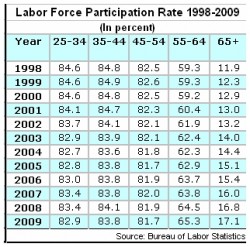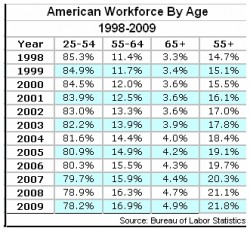CareerBuilder says unemployed older workers are having a tough time finding jobs. A survey released last week says only 28 percent of workers over 54 laid off in the past 12 months found new jobs compared to workers 25-34 who are quicker at finding work. In that age group, 71 percent found a job within 12 months.
As a result, says CareerBuilder, 63 percent of the 55 and up group have applied for lower-level jobs, including entry-level positions and even internships.
That’s probably not much of a surprise to recruiters; 37 percent of them told CareerBuilder they have received applications for entry-level jobs from retirees and workers over 50.
What may well come as a surprise is the rise in older workers and the impact the recession is having on their ranks.
 Layoffs and job losses have hit the younger workers hardest. According to data from the Bureau of Labor Statistics in the 18 months since January 1, 2008, the number of workers in the 25-54 age group has declined by 5.1 million. For workers over 54 though, there are 624,000 more working. In fact, there were gains in the number of older employed workers in every age group the BLS tracks except one — 55-59 year olds who saw a modest decline of 79,000 in the 18 months.
Layoffs and job losses have hit the younger workers hardest. According to data from the Bureau of Labor Statistics in the 18 months since January 1, 2008, the number of workers in the 25-54 age group has declined by 5.1 million. For workers over 54 though, there are 624,000 more working. In fact, there were gains in the number of older employed workers in every age group the BLS tracks except one — 55-59 year olds who saw a modest decline of 79,000 in the 18 months.
Before you point out that the sheer number of older Americans has been rising, which is certainly true, consider for a moment the participation rate. Based on a monthly survey conducted by the U.S. Census for the BLS, the participation rate is independent of population size. It describes the percent of various population groups in the labor force.
 The data shows that for the last 10 years, more and more older Americans are working. Since 1999, the percent of working Americans 55-64 has grown by 10 percent, while the over 64 age group has jumped — and that’s an apt word — by almost 40 percent. Contrast those changes to the 25-34 year olds who have declined from 84.6 in 1999 to 82.9 percent for the six months ending in June.
The data shows that for the last 10 years, more and more older Americans are working. Since 1999, the percent of working Americans 55-64 has grown by 10 percent, while the over 64 age group has jumped — and that’s an apt word — by almost 40 percent. Contrast those changes to the 25-34 year olds who have declined from 84.6 in 1999 to 82.9 percent for the six months ending in June.
In the 61 years for which the BLS has data, this many older Americans have never been employed. In the mid-50s the percentage began to rise until 1967 when, at the peak, an average of 62.3 percent Americans aged 55-64 worked. The percentage began to decline until it bottomed in 1986 at 54 percent of the age group working. There it remained, rising modestly until the recession of the 90s when it started its upward climb.
Even more dramatic has been the number of those 65 and over reentering the workforce. For years, between 11 and 12 percent of retirement age Americans have worked. In 1998, on average, 11.9 percent of the 65 and over group worked. In June, it was 16.8 percent.
The explanation for the uptick in older Americans working is not too difficult to guess at: Longer life spans, better health, and access to health insurance whether private or through Medicare, the decline of the defined benefit pension coupled with the increase in the Social Security age, and, in the last two years, the recession, which has devastated many workers 401(k)s.
The implications, however, are harder to forsee, as is deciding if this is a structural change in the American labor force or a temporary economic blip. A BLS economist told me a colleague of his is researching these very questions.
 Regardless of the cause of the return to work by older Americans, there’s no denying the graying of the workforce. For the first six months of this year workers 55 and over accounted for 21.8 percent of the labor force. That’s the highest percentage since 1971.
Regardless of the cause of the return to work by older Americans, there’s no denying the graying of the workforce. For the first six months of this year workers 55 and over accounted for 21.8 percent of the labor force. That’s the highest percentage since 1971.
Meanwhile, the percentage of 25-34 year olds has taken a nose dive. From a high of 36.6 percent in 1986, the percentage has dropped 11.5 points to 25.1 percent for 2009. For the 25-54 year age group as a whole, there’s been a decline of almost eight points since 1993, when 86 percent of the workforce fell into that age group. For the first six months of 2009, 78.2 percent do.
Consider now the demographic factors we’ve detailed: an aging workforce, reentry into the workforce by workers who in years past would be retired, lower workforce participation by workers in the entry-level age group of 25-34, and, finally, the sheer reduction in employment by that age group caused by layoffs and other factors.
The implications of this are immense for employers and recruiters.
Among them is the increase they are seeing in mature workers seeking jobs. That 37 percent of recruiters who told CareerBuilder they’ve received applications from mature and retired workers for entry level jobs is, therefore, not that much of a surprise after all.
Even though the CareerBuilder survey says 65 percent of the employers report being willing to consider overqualified candidates, the reality is probably closer to the 44 percent of mature workers who say they’ve been told they are overqualified. Recruiters who reject overqualified mature workers may find it increasingly difficult to find the young workers who might otherwise take those jobs.
Should recovery from the recession prove to be as long as some economists are now fearing, retirements will continue to get pushed off and retirees with diminishing payouts from their 401(k)s and other savings will reenter the workforce at an accelerating pace.
Evidence of the former is in the CareerBuilder survey. One in five employers report being asked by employees to postpone retirement. Most of those employers (86 percent) said they would consider it.
If the demographics are any guide, 100 percent may come to wish they did.